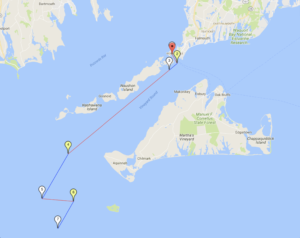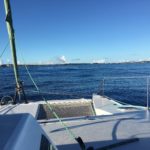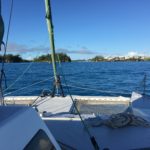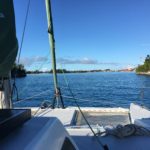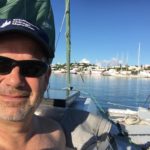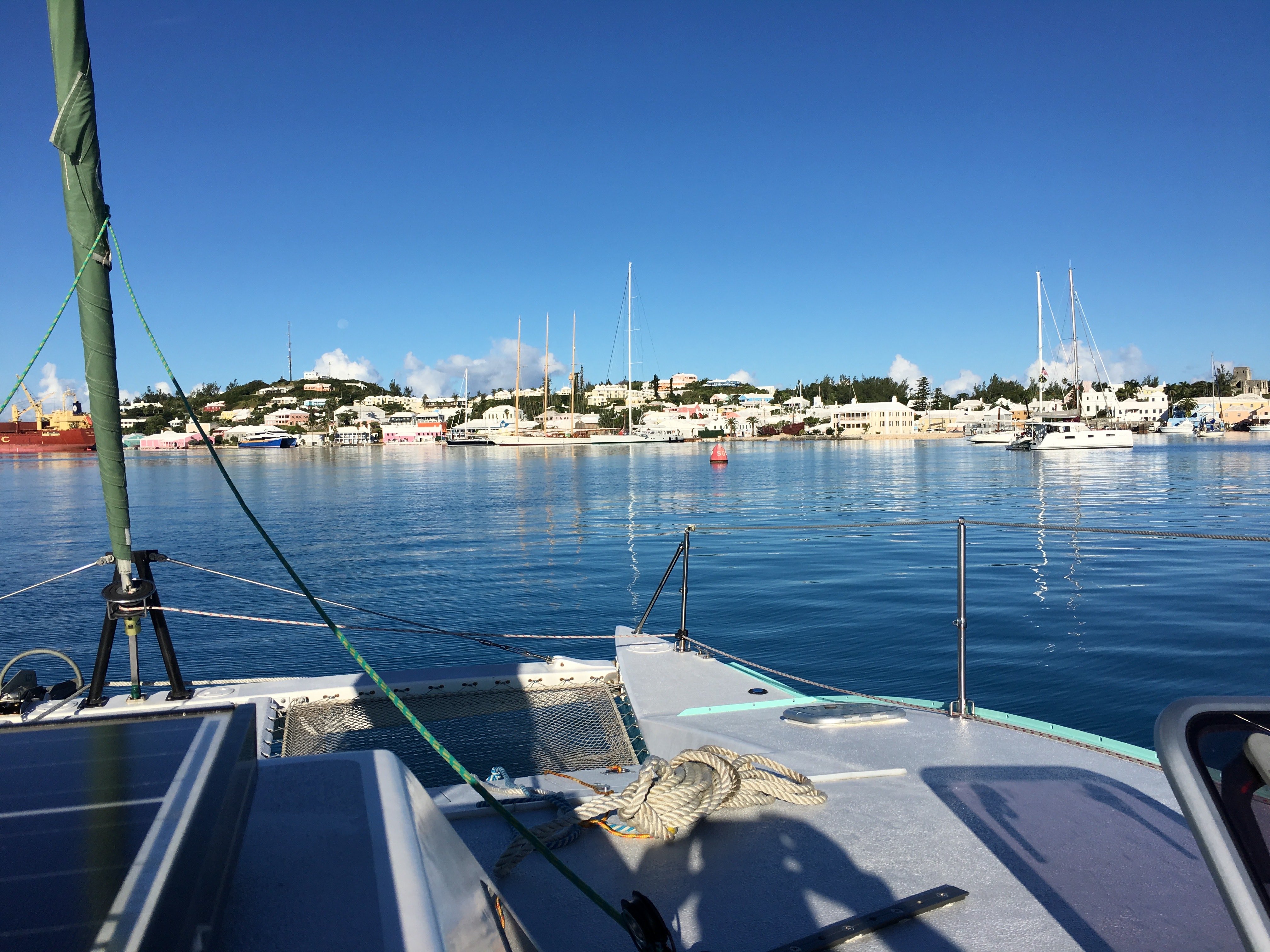
We Became Seafarers!
November 11th, 2017 - By Patrick T. McBriarty
It has been a week since we cleared Bermuda Customs after arriving,”by private yacht.” We will visit Customs tomorrow to clear out and begin sailing Leg 2 to the Virgin Islands. The last week of easy days in St. George’s Harbor has been a nice respite. My typical day started between 6:30 and 7:30 a.m. brush my teeth, wash hands and face, decide whether or not to wear the same shorts again, 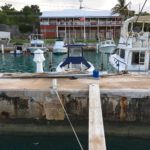 a fresh t-shirt, and finding a small bite to eat. Then walk the plank to the docks and up to the second floor balcony of the Sports & Dinghy Club to do some work. Blue would usually join me too do homework. He is completing his sophomore year of High School remotely to take this trip with his dad. Call this his half-year at sea.
a fresh t-shirt, and finding a small bite to eat. Then walk the plank to the docks and up to the second floor balcony of the Sports & Dinghy Club to do some work. Blue would usually join me too do homework. He is completing his sophomore year of High School remotely to take this trip with his dad. Call this his half-year at sea.
Usually around 10-ish we have breakfast. In the meantime, Brian (Blue’s dad) has been working on one more projects on the boat. We help him as the occasion warrants, but most of the time he is content to do these projects himself, likely a pleasant break from the hectic pace of running two small business.
In Bermuda, you must be at least 18-years old to rent a scooter, so Blue’s Michigan moped license is useless. Though relegated to riding “bitch” behind Brian he does not wine or complain, unlike a typical teenager, and takes it all in stride. Our rented scooters are a great way to get around Bermuda which more than 20-million years ago rose 15,000+ feet out of the ocean basin to form this oblong reef and archipelago. On a sailing chart, it looks like a small glob of paint flung at a huge sea-blue canvas. First colonized in 1609, Bermuda is now home to a diverse population of approximately 66,000 residents. It is an exotic destination hosting a half-million tourists every year that mostly arrive by air. Causeways connect most of Bermuda’s islands to make up the South, Middle, and North Roads carrying a multitude of scooters and motorbikes, and smaller percentage of cars, trucks, and busses.
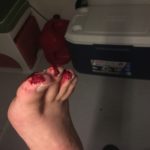
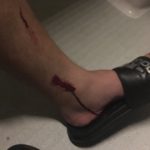 Bermuda, though beautiful and fun, is not the most interesting part of this trip, and aside from a scooter capsize (I tore some flesh and scrapped up my toes) our days are easily summed up. We are relaxed and do a bit of work in the morning while afternoons are spent running errands and checking out the islands’ beaches, restaurants and bars. What people are really curious about is what it is like to sail on the ocean, particularly on a small boat — in our case a 33’ catamaran named Dragonfly. This is not a cruise ship experience. Before this trip I was having difficulty imagining what it would be like sailing so far from dry land.
Bermuda, though beautiful and fun, is not the most interesting part of this trip, and aside from a scooter capsize (I tore some flesh and scrapped up my toes) our days are easily summed up. We are relaxed and do a bit of work in the morning while afternoons are spent running errands and checking out the islands’ beaches, restaurants and bars. What people are really curious about is what it is like to sail on the ocean, particularly on a small boat — in our case a 33’ catamaran named Dragonfly. This is not a cruise ship experience. Before this trip I was having difficulty imagining what it would be like sailing so far from dry land.
Sailing to Bermuda it feels like it is in the middle of nowhere. From Onset, MA from whence we began Bermuda was 650 miles and is a similar distance from the Carolinas. However Bermuda is just a short romp when compared to the 3,300 miles of an Atlantic crossing, which usually includes a stop in the Azores or Canary Islands about 1,000 miles from Europe. In an earlier blog post I expressesd my anxiety about the trip and a second post talks about our preparations. The vastness of the ocean is daunting and Brian, Blue, and I need to be completely self-sustaining. The Coast Guard was at least a day or more away for most of the trip and all the spare parts, extensive first aid kit, backup components, tools, and hardware had to fix or replace anything that broke.
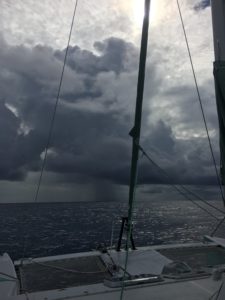 Some would ask, “why do this? What if there is a storm?” Traditionally sailors are obsessed with studying the weather, and today’s sailors are no different subscribing to various weather reporting and forecasting services. Access to multiple weather applications is common to gain more detail and insight to local conditions and the high and low-pressure systems moving across the globe in order to tease out a good “weather window.” Generally systems with 35-40 knots (or more) of wind are avoided. There are always a few sailors who do take on such storms. (I do not know why.) They are both heartier or crazier than I. Of course, thunder cells and squalls are always a risk with winds of 25-35 knots, but unless driven by a large system typical ocean winds rarely exceed 35 knots. Most sailboats are designed to handle gales or even hurricanes, so if the worst does happen a boat can withstand it and sailors have options, such as shortening sail or heaving-to. Shortening sail usually means taking a reef or dropping a sail all together. Reefing a mainsail is accomplished by lowering the halyard (the rope that raises the sail on the mast) and tightening (one or more) reefing lines to take large slabs of sail area out of the wind and securing it to the boom.
Some would ask, “why do this? What if there is a storm?” Traditionally sailors are obsessed with studying the weather, and today’s sailors are no different subscribing to various weather reporting and forecasting services. Access to multiple weather applications is common to gain more detail and insight to local conditions and the high and low-pressure systems moving across the globe in order to tease out a good “weather window.” Generally systems with 35-40 knots (or more) of wind are avoided. There are always a few sailors who do take on such storms. (I do not know why.) They are both heartier or crazier than I. Of course, thunder cells and squalls are always a risk with winds of 25-35 knots, but unless driven by a large system typical ocean winds rarely exceed 35 knots. Most sailboats are designed to handle gales or even hurricanes, so if the worst does happen a boat can withstand it and sailors have options, such as shortening sail or heaving-to. Shortening sail usually means taking a reef or dropping a sail all together. Reefing a mainsail is accomplished by lowering the halyard (the rope that raises the sail on the mast) and tightening (one or more) reefing lines to take large slabs of sail area out of the wind and securing it to the boom.
Shortening (or decreasing) sail makes the boat more stable and lessens the effects of the wind. Most mainsails have at least two reef points, as Dragonfly did. Similarly, the jib (or front sail) is on a roller-furler system to shorten sail at the front of the boat (or pointy end). It allows rolling the sail around the wire (or forestay) that runs from the bow of the boat to the top of the mast. It is a quick and easy method for adjusting the sail area and affords completely rolling the sail up such for motoring or when docked.
This all sounds technical and of course there is (like anything) a whole world of terminology, knowledge, and skills around boats, that folks can spend a lifetime mastering. Essentially what I am saying is, “Yes, sailing can be scary, and the Atlantic Ocean is a big place,” but sailors consider the worst that can happen, develop skills, and experience to gain a reasonable sense of safety to take on such trips.
Brian purchased Dragonfly specifically to cruise to the Caribbean with these risks in mind. He has extensive cruising experience, skills, and confidence and added the necessary technology and equipment to minimize the risks. We were prepared to handle and hopefully master any situation that might arise. Smart sailors have a plan with options, and ideally the skipper and crew know the limitations of their boat, their skills, and react quickly to situations as needed to affect safe alternatives. And if the situation warrants abandon the original plan.
Knowing all this and more about boats, sailing, and weather even the best sailors have apprehensions. I am not sure if I had more or less than the typical sailor heading for Bermuda, but the gale that blew through Onset before our departure was actually reassuring. It gave us more time to prepare as twice we pushed back our departure for better weather, highs in the 60s were expected to change to 30s and 40s, and post-storm the weather is almost always fair. So it was time to leave, high winds cannot last indefinitely. We knew the boat had successfully made it to the Caribbean and back two years earlier. It was more than seaworthy, and we were confident it could capably handle 25-35 knot winds after our sail two days prior. These were Monday’s best laid plans . . .
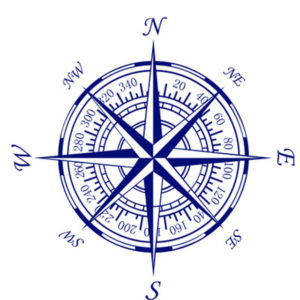 Tuesday morning the wind was still howling straight up Buzzards Bay. Exactly the direction we wanted to go. Sailboats are designed to use wind (which is free) for propulsion. The downside is they cannot sail directly into the wind. However knowing the forecast would improve we set out and motorsailed (at 25-35° off the wind) sticking close to the western shore (under Cleveland Ledge and Centerboard Shoals) to stay out of the larger chop and waves. The idea was to work our way down the bay, tack and angle off the wind (60-45° ) down the bay. The 28-35 knots of wind from the southwest (250°) would offer a nice reach toward our destination once on the open ocean. However, getting down Buzzards Bay involves navigating a series of islands stretching to the southwest before reaching the ocean. Once there we would turn southeast and make a bee-line (or in sailing terminology “rhumb line”) for Bermuda. Yes, sailing and navigation involve a lot of angles and geometry. As the trip progressed I used a small notebook to log our course, figure wind and course angles, and record the trip.
Tuesday morning the wind was still howling straight up Buzzards Bay. Exactly the direction we wanted to go. Sailboats are designed to use wind (which is free) for propulsion. The downside is they cannot sail directly into the wind. However knowing the forecast would improve we set out and motorsailed (at 25-35° off the wind) sticking close to the western shore (under Cleveland Ledge and Centerboard Shoals) to stay out of the larger chop and waves. The idea was to work our way down the bay, tack and angle off the wind (60-45° ) down the bay. The 28-35 knots of wind from the southwest (250°) would offer a nice reach toward our destination once on the open ocean. However, getting down Buzzards Bay involves navigating a series of islands stretching to the southwest before reaching the ocean. Once there we would turn southeast and make a bee-line (or in sailing terminology “rhumb line”) for Bermuda. Yes, sailing and navigation involve a lot of angles and geometry. As the trip progressed I used a small notebook to log our course, figure wind and course angles, and record the trip.
After several hours we set full sail, turned off the engine and ventured out into the wind and 3-5 foot waves of Buzzards Bay. Dragonfly handled the conditions well. Luckily it was sunny and reasonably warm (50s), but as the swells became 4-6 feet the best course (195°) we could make was 65° off the wind. Most sailboats (monohulls) can sail quite well (typically 45°) off the wind (even in chop and waves). With two hulls a catamaran offers a nice stable platform (much less heel than a monohull), but cannot sail as close to the wind. This left us heading across the bay, rather than down it. Looking at the chart and the angles I soon figured out we would need 4-5 tacks to get to the mouth of Buzzards Bay. It would mean going 4-5 times the distance and many hours to get the necessary 15 miles. It would be dark before reaching open ocean. Our current angle pointed us just to the west of Woods Hole, a mere 17 miles from Onset. Not a fantastic start when we had hopes of covering as much as 200 miles a day.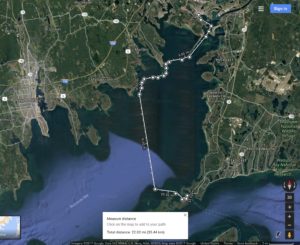
Woods Hole is a tricky bit of water tucked in a cut between a peninsula at the corner of Cape Cod and islands with names like Naushon and Nonamesset. The cut contains shallow rocks right in the middle of the channel, and if you have not been there before navigating is tricky. We decided to get off Buzzards Bay and duck in and try another route. In Woods Hole both red and green bouys seemingly right next each other which can easily be misinterpreted and create danger even for a very shallow draft boat, like a catamaran.
I hate to admit it, but in broad daylight we suddenly banged 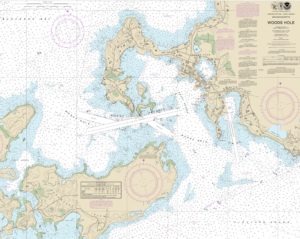 into some rocks inches below the surface. Running aground is a fear of every sailor and we hand just nailed the dagger board and banged up our rudder before getting free. It happened in an instant and in retrospect, we should have dropped our main sail and motored at a crawl in these unfamiliar waters. The chart on the iPad offering an overview perspective complicated our navigation. Looking at it and turning left on the screen in reality means turning right. This dyslexia added to our momentary confusion and misfortune. Tension on the boat spiked and a sinking feeling in the pit of my stomach rose to my throat choking speech. And now Brian was having trouble with the rudder. We could not sail another 600+ miles like this! Insert a string of explicatives here!! But for the moment no one spoke.
into some rocks inches below the surface. Running aground is a fear of every sailor and we hand just nailed the dagger board and banged up our rudder before getting free. It happened in an instant and in retrospect, we should have dropped our main sail and motored at a crawl in these unfamiliar waters. The chart on the iPad offering an overview perspective complicated our navigation. Looking at it and turning left on the screen in reality means turning right. This dyslexia added to our momentary confusion and misfortune. Tension on the boat spiked and a sinking feeling in the pit of my stomach rose to my throat choking speech. And now Brian was having trouble with the rudder. We could not sail another 600+ miles like this! Insert a string of explicatives here!! But for the moment no one spoke.
Internally I was chastising myself (feeling responsible) for being so stupid! The electronic chart had warned Woods Hole could be hazardous to navigate. Less than six hours into a long passage, this was NOT GOOD!!! All three of us were deflated, yet on high-alert. Brian though very tense dealt with this (and each subsequent situation) by acting quickly and initiating an action plan. He did not yell (unless needed) and did not get mad at us personally. The navigation was quickly sorted out in the tense moments afterward and we got into the deep water of Great Harbor. Drifting momentarily Brian and Blue determined that indeed the starboard rudder was obstructed. Most likely rubbing against the hull. (Shit!!)
Brian announced we would pick up one of the dozen or so unoccupied moorings in the harbor. A mooring nearby (thankfully) had a pickup bouy. These have a long fiberglass stick protruding from their top making it easy to grab 2-3 feet off the water, or about deck height of a small boat. These bouys are tied with a short line to the end of the mooring line, that is attached to the mooring bouy that is anchored to the seabed. Blue and I went to the bow with Brian’s high-pressure instruction, “Do not miss this mooring!” Another disaster would unconscionable.
Blue had a boat hook at the ready, while I grabbed the pickup bouy and pulled the ¾ inch, barnacle encrusted mooring line to the boat. As it got closer I tried not to get the rust-red staining crustaceans that fell through my hands all over the white hull while connecting the anchor bridle. Throughout, the wind pushed against the boat as if trying to pull the mooring line from my hands. Seconds felt like an eternity. Finally, I dropped the mooring line and bridle off the bow, and the wind pushed Dragonfly back to rest safely at anchor.
Our relief quickly evaporated turning toward the back of the boat to deal with the damage from hitting the rocks. The deck around the centerboard hardware had pealed up. Brian’s demeanor confirmed he was firmly in charge and set to address the situation. This left an awkward silence. Blue and I felt pretty helpless, but did not say a word. At the moment asking questions would not help.
Brian assessed the deck, gathered some tools and applied a liberal amount of quick-setting epoxy and a half dozen wood screws. This reattached the deck and hardware, which was left to cure. Brian then moved to the back of the boat to focus on the starboard rudder. Blue and I passed tools and parts back and forth as Brian took apart the tiller assembly connected to the starboard rudder post. Hyper-vigilant we were taking extra care not to drop anything in the water. The nylon collar and bolt setting the rudder height were damaged and with some effort removed. Brian was able to save the collar and next struggled but finally removed the bolt, which was ruined. His plan was to drill a new, slightly higher hole in the 1-1/4” diameter rudder post. If accomplished this would allow the rudder to hang an inch lower under the hull and restore proper steerage. Thankfully the collar can be flipped around, drilled, and reused. The hard part would be drilling the stainless-steel rudder post.
Brian, just inches from the water, situated on the swim platform with a cordless drill is straining to drill the hole. In relatively short order two drill bits are dulled and are no longer cutting, despite liberal amounts of lubricant (WD-40) throughout the process. Finally the cordless drill’s battery begins to die. We are at an impasse. Thankfully there is a voltage converter onboard and the battery gets put on its charger. Still, we need a hardware store and better drill bits!
How I cannot really say, but I remember learning about the Woods Hole Oceanographic Institute, which \ explained the institutional complex of buildings on the east side of the harbor. Looking up the number on my cell phone I realize it is late — a few minutes after 5 p.m. I call, hoping someone is still there. The person answering does not know about a hardware store, but does connect me with their maintenance guy.
(I think?) Bob, was his name, picks up and I explain our situation. He is mildly sympathetic, but about to leave for home. I hand the phone to Brian. They talk and of course, it seems the institute has a full machine shop. Sure they have carbon drill bits that will cut stainless steel. A strained back and forth ensues to determine which building and where to meet him. Brian hangs up. Blue and I launch the dinghy off the back of the boat, Brian mounts the outboard, and buzzes off.
We watch as Brian gets smaller and smaller and approaching the seawall a man walks out to meet him. In 10 minutes Brian is back with two ¼” carbon drill bits, and he never even has to get out of the dinghy. We stow the outboard and dinghy, and Brian gets to work drilling the hole. Blue and I again carefully hand back and forth tools, nuts, bolts, and washers to avoid anything dropping into the water. We need a new bolt for securing the collar holding the rudder in place. Brian knows the 3-4 kits of spare fasteners do not contain a good match.
“Wait a minute,” I say and go below. From under my bunk I pull out my sailing bag and fish around in one end. The carriage bolt from a Laser rudder is just where I left it. I hope it isn’t too long as I return topside. A week earlier emptying my sailing bag preparing to pack I almost left that bolt behind, but something told me it might come in handy. Sure enough it works perfectly and we were back in business! Daylight has faded as dinner gets underway and our mood lightens. We ease into discussing our situation and our new plan is to leave at first light. After all the fresh air, adrenaline, and drama we sleep well safe at anchor that night, oblivious to the howling wind.
Brian and I awake before sunrise to a flat, quiet harbor. There is no wind and after a few sips of coffee Brian drops the engine and starts it up as I undo the mooring line. We proceed out the cut and are passed by the morning ferry and are soon on Vineyard Sound. Brian sets up the autohelm on a course of 230° as a 5-knot breeze, 100 degrees off our port side, begins to fill. I make breakfast (eggs and bacon), and after eating Blue does the dishes. We motorsail at 5-1/2 knots and the breeze fills to a pleasant 12-16 knots from the southeast. At 11:20 am we tack onto starboard and sail an easterly course (95°) in 15-17 knots of breeze and 1-3 feet seas. We must tack again onto port to avoid Nomans Land to a course of 210° and stay on this for several hours to avoid the Nantucket Shoals. We are progressively knocked by the wind down to a heading of 215 – 220°. We really want to sail SE on a course of 140° but that is essentially where the wind is blowing from (160°). At 2:15 p.m. we back tack onto starboard again and a course of 85 – 90°.
About this time, there is some chatter on the VHF Radio. The vessel Enterprise at 41.10 N and 71.01 W hails a sailboat. We cannot hear the response and only catch half of the conversation. An hour or so later a VHF call from the clam boat Wanda River (at 40.58.210 N and 71.10.009 W) alerts the Coast Guard of a fire onboard. The two parties talk back and forth in a surprisingly calm manner. Luckily the clam boat’s crew is able to get the fire under control. Apparently something was lying on the exhaust pipe (that should not have been) caused the fire. The Wanda River will head for New Bedford harbor. Everyone is alright and the Coast Guard will continue, “standing by on Channel 16.”
Around 3:15 pm I go below, anticipating a late night and early morning watch, leaving Brian and Blue on deck. After about an hour of sleep I come back up. It’s 5 p.m. and while I was below Brian started the engine. We are motorsailing on a course of 105°, which is at least closer to the rhumb line. The wind is at 5-10 knots over a sloppy sea of 1-3 foot swells and chop. By 5:45 p.m. the wind shifts 30°. We are still motorsailing without the jib at 4-5 knots on a course of 150-155° – more or less the rhumb line toward Bermuda! Our calculated arrival time drops from 11-10 days to 5 days, yeah!
The trip has begun in earnest. Brian and I casually alternate minding the course, adjusting sails, fixing meals, and using the engines to make way toward Bermuda. Although we consult one another, Brian has final say and does the majority of the sail trim and autohelm adjustments. I track navigation and make the occasional suggestion that may or may not be adopted. I accept this support role for several reasons: it is Brian’s boat, his and Blue’s trip to cruise for the next six months, and Brian’s experience far outstrips my own. Though I usually prefer having more control, I try and keep most objections to myself. This internal conflict surrounds reconciling my sailing experience racing sailboats with cruising. Ocean passages with its own fears on open water day after day for nearly a week is very different than racing a regatta.
None the less, a loose routine develops best portrayed by the ships log to capture our days free of the news (and Trump!) taking in the rhythm of our outside influences the sun, stars, wind, and waves . . .
Ship’s Log
Thursday, 11/2/20178, 8:05 am – Windy night! 20-25 knots FON [Fucking On the Nose]. The wind knocked us from yesterday at 10 pm to 4 am this morning. I was on watch from 10:30 pm – 2 am. Brian took the 2-6 am shift. Was really dark from 5:40–6:40 am. Dawn stared about 6 am. Blue came up on deck about 7:15.
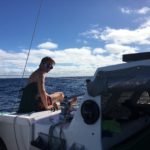
Last night around 11:30 pm a large ship crossed us, then we crossed a fishing boat. Its bright spotlight from the wheelhouse stayed on me throughout. Right now AW [or AP for apparent wind is] 18-20 knots, 55° off our course of 210°. The wind is [from the] NE (155°). Seas 2-5’. Temp.s 50s, low 60s, overcast high clouds. We are east of our rhumb line by about 42 NM [nautical miles] over Block Canyon directly south of Martha’s Vineyard.
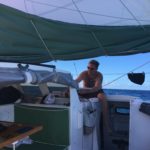 12:05 pm – Had breakfast of eggs-in-the-hole & sausage. Thanks Brian (10:45 am). Sailing 205° w/ wind off the port side at 55° to 60°. Doing 6.5 – 8 knots in a 2 – 4’ swell. About 150 miles off NYC. Have gone 124 miles toward our dest. (assumes 650 to Bermuda) however we’ve sailed much further due to head winds.
12:05 pm – Had breakfast of eggs-in-the-hole & sausage. Thanks Brian (10:45 am). Sailing 205° w/ wind off the port side at 55° to 60°. Doing 6.5 – 8 knots in a 2 – 4’ swell. About 150 miles off NYC. Have gone 124 miles toward our dest. (assumes 650 to Bermuda) however we’ve sailed much further due to head winds.
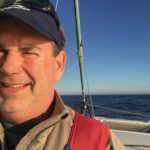 2:00 pm – Got a 20-25° lift about ½ hr. ago now sailing 180° to 175° at 5-6.5 knots. Wind is at 130°. Apparent wind 11-13 knots. Brian up from a nap & we rolled the jib all the way out & tightened the Main Halyard. Blue sky w/ high cirrus clouds.
2:00 pm – Got a 20-25° lift about ½ hr. ago now sailing 180° to 175° at 5-6.5 knots. Wind is at 130°. Apparent wind 11-13 knots. Brian up from a nap & we rolled the jib all the way out & tightened the Main Halyard. Blue sky w/ high cirrus clouds.
4:00 pm – Awoke from a nap to Brian frying Nathan’s hot dogs and clear skies, a soft swell and 8-9 knots. We are making 4.4–4.8 knots at 175-171° – about 198 miles due east of the Mouth of the Delaware River. We are ~100 miles west of our rhumb line and 510 miles from Bermuda on a course of 140°.
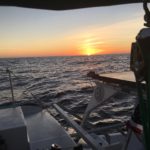 4:30 pm – Motor sailing at 150-140°. Main & stbd. Engine.
4:30 pm – Motor sailing at 150-140°. Main & stbd. Engine.
6:33 pm – Brian went down for a nap. Blue crashed about an hour ago and missed the sunset. It was pretty. Motor sailing, small jib out, main & stb. engine, both boards down, 4 knots at 140° – toward Bermuda. Dest. 509 NM est. arriving on Sun. or Monday. Listening to Sirius Radio, New Wave and the engine hum as the waves go by slightly slapping the hull with a pitter-pat of some unknown rhythm.
I’ll reheat some frozen mashed potatoes, fry some pork chops and canned corn for dinner at about 8. Brian figured he’d be up about 7:30 & Blue should be up by then.
Last night Brian took the 7-10 pm shift. I did 10-2 and Brian did 2-6, then I took 6-8-ish. We will probably do something like that again tonight. Last night Blue was feeling a bit sea sick & was in his bunk most of the night after about 10. He’s an easy-going kid to do all this, as last night was pretty rock’n with winds in the 20s and waves at least 4-6’ maybe 5-10’ and we were on a lose beat at about 50° off the wind. Pretty good for a catamaran.
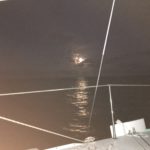 6:46 pm – Clear sky tonight and almost a full moon s.b. great star gazing. The Doghouse on this boat is great. You are mostly, if not totally, out of the wind with benches & a table & wrap around shelf for odds and ends.
6:46 pm – Clear sky tonight and almost a full moon s.b. great star gazing. The Doghouse on this boat is great. You are mostly, if not totally, out of the wind with benches & a table & wrap around shelf for odds and ends.
Last night Brian talked w/ Melissa [on the satellite phone]. She had learned Brian’s wife (they are separated) was dating a another guy. Brian seemed relieved to have an explanation for her distance and why the relationship fell apart. He didn’t get much deeper but hated being seen as a meal ticket.
10:30 pm – Just came on watch after a nap. Brian just went down for some sleep. Beautiful night, clear sky, wind 10.8 AP motorsailing at about 6 knots on a course of 142° but being set [pushed] north by the Gulf Stream to an actual course of 132°, showing 490.4 NM to go. Light wind at about 100°
Had a nice talk w/ Briand after dinner (Blue crashed) about women, life, finding the right one… Enjoying the music while sailing/motoring. 80s New Wave
11:46 pm – On watch and an autohelm is a great thing, because it allows you to roam the deck and dance! 🙂
Friday, Nov. 3, 2017 2:25 am – Finally a favorable wind. About 30-35 minutes ago the SE wind began to veer E and is actually at 75-80°. We are on a reach and making 6.5+ knots toward Bermuda. Tonight has been motorsailing, but pretty conditions. About 11:30 pm some clouds came in from the SE and covered the moon quite a bit. However by 12:15 they cleared to open sky. Even w/ the wind at 70° off our heading we have 10-11 apparent, most [half?] is probably due to the extra push of the motor. I’ll probably go until 3 am, then get some sleep.
12:45 pm – Early this morning we motorsailed through the Gulf Stream. Huge rollers some must have been 15’ or poss. more. Regular 10-12 footers when we crossed the Stream at about a 90°, the wind was from 60-90° off our course. Pressure was 10-17 knots.
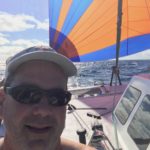 Played around w/ the spinnaker after breakfast of scrambled eggs w/ bacon, sausage, and ham. This was delayed by a broken solenoid that Brian removed and by passed. We now turn on the propane gas for the stove via the valve on the tank, siting in the outboard corner of the transom. Spinnaker worked out great reaching, but eventually the wind was almost directly astern and the sail kept collapsing. The wind died further so we gave up and dropped it to motor w/ the main up. Making 5+ knots on the rhumb line. I think Brian & I are both a bit tired from playing with the spinnaker a good part of the day.
Played around w/ the spinnaker after breakfast of scrambled eggs w/ bacon, sausage, and ham. This was delayed by a broken solenoid that Brian removed and by passed. We now turn on the propane gas for the stove via the valve on the tank, siting in the outboard corner of the transom. Spinnaker worked out great reaching, but eventually the wind was almost directly astern and the sail kept collapsing. The wind died further so we gave up and dropped it to motor w/ the main up. Making 5+ knots on the rhumb line. I think Brian & I are both a bit tired from playing with the spinnaker a good part of the day.
1:30 pm – Spotted first ship of any kind for at least 24 hours. It is headed west & is several miles off our port bow.
Saturday, Nov. 4, 2017, 2:05 am – When you are tired you don’t confront your fears or necessarily do the right thing? Possibly . . . At about 1 am the engine quit and instead of restarting it (I hadn’t had to start it yet), I played the sails hoping I could keep the boat going at 5 or more knots. Despite best efforts there just wasn’t enough wind for our downwind course. However, it was nice and quiet just the wind and water working on the boat. No constant hum and vibration of the engine droning on and on.
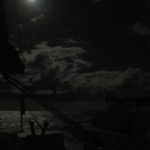 Brian felt the difference and and came on deck. He knew we weren’t making way as was wanted. So after a minute of watching me play with the sails and seeing the speed at 3.5 – 4.5 knots he was like, “Why didn’t you restart the engine?”
Brian felt the difference and and came on deck. He knew we weren’t making way as was wanted. So after a minute of watching me play with the sails and seeing the speed at 3.5 – 4.5 knots he was like, “Why didn’t you restart the engine?”
“Thought I could keep it going sailing,” was my reply.
“Appreciate your optimism, but if we don’t keep at least 5.5 knots we won’t get to Bermuda until Tuesday,” or after dark on Monday. He didn’t want to do that. So we are back to motorsailing. The frustration is the jib just refuses to constantly work. We’re sailing near dead downwind and it constantly stalls out behind the main – fills briefly or looks like it might fill and collapses. Helping it and tending the sail seems to make little difference. Also, I’m tired. It’s been three days of night shift interrupted sleep, usually 10-2 or 11-3 or like tonight midnight to 4 am and switching off with Brian to manage the boat.
I’m looking forward to a full 7-8 hours of sleep upon reaching Bermuda. Wish we had true wind speed instrument and a knot meter this boat. The difference between racing and cruising is wider than I imagined and a very different style of sailing. Have to be a lot more self-sufficient. Brian is very good at that and tackling problems. Also accepting decent sail shape and setup, in light of just being out here.
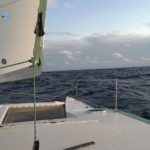 “We are Seafarers,” is Brian’s refrain on this trip. It is true (though said with great humor) as we are truly out on the ocean and simply working with the conditions at hand. Thankfully the wind has picked up a bit over this shift and gone to the port-aft quarter from astern or slightly stbd. The wind just piped up to 8-10+ apparent and had to step away to trim the jib so now we are occasionally hitting 8-knots COG [Course Over Ground]. It has also shifted to the east (left) 15-20°. The greater pressure makes sense as we are under some clouds and sailing (thankfully) w/ a full moon. Okay out of chatter for now, and tired. It’s 3:18 am and will have Brian come up about 4 am so I can catch a nap.
“We are Seafarers,” is Brian’s refrain on this trip. It is true (though said with great humor) as we are truly out on the ocean and simply working with the conditions at hand. Thankfully the wind has picked up a bit over this shift and gone to the port-aft quarter from astern or slightly stbd. The wind just piped up to 8-10+ apparent and had to step away to trim the jib so now we are occasionally hitting 8-knots COG [Course Over Ground]. It has also shifted to the east (left) 15-20°. The greater pressure makes sense as we are under some clouds and sailing (thankfully) w/ a full moon. Okay out of chatter for now, and tired. It’s 3:18 am and will have Brian come up about 4 am so I can catch a nap.
4:07 am – Sent a text to Matt [my brother], “We are enjoying the weather – barefoot tonight on the late watch from midnight to 4, but may stretch it to 5 am as the wind picked up and we are humming along on the rhumb line toward Bermuda at 6-8 knots depending on the wind & catching waves (2-4’). The Autopilot is steering so watch is not bad. Tell Sofia, Alex, and Owen [my niece and nephews] I say hello. Cheers, Patrick”
Been listening to Van Morrison the last half of this watch and at 3:30 put a splash of Kracken (rum) in my tea. So the last half has been pretty good given how tired I am. Also used the head so feel pretty good too.
4:25 am – The moon which is full tonight is setting later and later this cycle, which is nice as we now will not have completely dark nights the last 1-2 hours before dawn. Can see from a couple nights ago where the saying, “it is always darkest before the dawn,” comes from – because when there is no moon it is so damn dark! [Can barely see the horizon.]
4:39 pm – It must be blowing 18-22 as we are doing 6 to 8 knots with apparent wind of 10-14 at 100-120° off our course of 140°. So a northeast wind of 20-40°. Still pretty warm in shorts, a long sleeve tech-shirt, plaid long sleeve shirt and barefoot. Wind seems to be clocking around from 120 – 100° [apparent].
4:45 am – These conditions really deserve a spinnaker, but it is too much to do at night by myself. As it would be nice to not have the motor running.
4:52 am – Throttled back the motor and was able to maintain 6-8 knots so killed the engine and pulled it up. Finally sailing! Wind is 130-120° apparent to course and 10-13 knots AP. True wind must be about 19-24 from 20-40° (NE). Okay I think I am exhausted for the evening. Briefly a puff and wave 12.4 knots COG w/ just a main & jib!
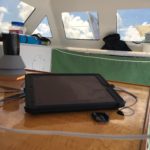 2:46 pm – Its been honking since early this morning from the NE during Brian’s morning shift and has continued all day 18-25 knots. The wind slowly clocked to the right. Initially at 20-40° we have sailing the rhumb line all day at about 145°. So the wind is now at 70°. We are 222 NM out. Sunny and partly cloudy, seas 3–6’, mostly 3-4. Lunch was chicken Quesada’s thanks to Brian. The distance we have covered [the last 24 hours] has been great for our ETA. Averaging over 7.5 knots – often solid 8s & 9s.
2:46 pm – Its been honking since early this morning from the NE during Brian’s morning shift and has continued all day 18-25 knots. The wind slowly clocked to the right. Initially at 20-40° we have sailing the rhumb line all day at about 145°. So the wind is now at 70°. We are 222 NM out. Sunny and partly cloudy, seas 3–6’, mostly 3-4. Lunch was chicken Quesada’s thanks to Brian. The distance we have covered [the last 24 hours] has been great for our ETA. Averaging over 7.5 knots – often solid 8s & 9s.
3:37 pm – Brian’s going to take a snooze. We have 215.7 NM to go to our mark 5 miles off the “SB” Mark designating the Cut entrance into Bermuda. Computer estimates at this speed ~8 knots and 1 day +0-6 hrs. to our destination.
5:37 pm – Rocking & rocky as we reach for Bermuda on the rhumb line. 199 NM out doing 8 knots. Course 155°. Wind is at 85° or 70-75° off our Port. Sunset and the waves are laying down a bit, but still choppy. Brian is napping, just me and Blue watching our progress from the Doghouse.
Sunday, Nov. 5, 2017 @ 2:54 am – Sailing rhumb line at about 6-7 knots 138 NM from Bermuda. Similar wind since last entry, although we reefed the main around 10 pm. Huge dark cloud formation dead ahead – altered course up to rhumb line – ended up passing between T-cells. Rained a bit and wind dropped (Brian had to motor a while to get through). Now sailing w/ reef until morning. The clouds and lighting made us really nervous. Somehow skated through w/ a lot of anxiety, but no ill effects.
4:37 am – Started the engine at 4:15 – wind had dropped and moved right so our speed was 4-4.5 knots.
11:33 am – Showered and shaved my neck, fresh shorts, and its sunny, puffs of clouds. Light wind of 4-5 knots on the nose. Motoring at 5-6 knots at 139° toward Bermuda 90.9 miles away.
 Shall arrive early (dawn?) Monday morning. Scary night with the lighting in the clouds around us and difficult to know how far away or how bad the cell is in the moonlight. It is confronting fear and preparing for the worst – we set the second reef in the main and then going forward to accept what we get. So after all that we just got a little rain. Still we went right between two cells and then a line of cells with lighting beyond that either broke up or passed away to either side by the time we got there. It was if by providence, God or good fortune smiled on us and our rhumb line.
Shall arrive early (dawn?) Monday morning. Scary night with the lighting in the clouds around us and difficult to know how far away or how bad the cell is in the moonlight. It is confronting fear and preparing for the worst – we set the second reef in the main and then going forward to accept what we get. So after all that we just got a little rain. Still we went right between two cells and then a line of cells with lighting beyond that either broke up or passed away to either side by the time we got there. It was if by providence, God or good fortune smiled on us and our rhumb line.
This morning after two 45 min. naps, post watch (2:30 am – 6 am) I woke from a third nap at 8:30 am crying. Exhausted in need of a shower I had dreamed about Barb. Not like past dreams where she visited me. This was like someone was showing me a video of her with a group near a long ago wrecked airplane or ship on the beach and she straddled a nurse shark as did the others testing their fear and bravery. It seemed even in the dream a bit false by the way Barb reacted and what she said. But who could tell for sure. All I know is seeing her and the feelings of wanting, frustration and hurt, of her not being here left me in tears. It was a good cry like I haven’t had in about 2 years. That took me back to crying in front of a woman I was seeing at the time and how I missed that sense of truly feeling safe. A feeling I haven’t had in a long time and dearly miss.
This being November and wanting to assign meaning to it, I wondered if this was the anniversary of Barb’s death [Nov. 3, 1999]. I purposely left those details behind a year or so after they happened as one of many ways of moving forward, and not dredging up the past year after year. I already had/have plenty of reminders. Thinking of some of this earlier this morning I knew I needed to get this down and that it fit with the theme of this trip — that it is about something bigger. Bigger than just challengers of sailing to Bermuda in late Oct. or early Nov. Brian was also widowed and going through a second divorce, and Blue had lost his mom, Brian’s first love and first wife. The three of us were each carrying scars.
Not that they defined us or that they stopped us from reveling and enjoying life, but that we knew things and had experienced life lessons few others had at a young age. It did in a way set us apart. And it at least for me, pushed me to make the most of opportunities and life experiences when presented, like this trip. When it came to relationships, God knows I am still (and always was) cautious. Probably more sensitive than I let on to rejection and getting hurt or hurting others, as I also take responsibility all too easily to my benefit & occasional detriment.
I am still tired and have plenty more thoughts and tangents on loss, crying (usually a good thing in the long run – letting out bottled up emotions) and all this stuff is connected and bigger than we are – fear or no fear and about taking chances. Lessons learned and lessons yet to truly learned, let alone mastered. Knowing and feeling you can do the right thing or open yourself up and share who you are. As a friend Robin (Barb’s best friend) often said with a rye smile or chuckle, “Life can be tricky.”
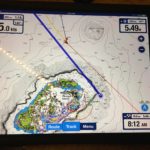 5:44 pm – Checking navigation [in advance of] entering St. George’s Harbor. We will approach from the east near mark “SB” on a course of 265° toward the red and green cans. The course is 261° down Town Cut. Keep “Split” and the green can “2” to left going into Town Cut between red can “SG1” & green “SG2,” red can “SG3” & “SG4.”
5:44 pm – Checking navigation [in advance of] entering St. George’s Harbor. We will approach from the east near mark “SB” on a course of 265° toward the red and green cans. The course is 261° down Town Cut. Keep “Split” and the green can “2” to left going into Town Cut between red can “SG1” & green “SG2,” red can “SG3” & “SG4.”
Monday, Nov. 6, 2017, 2:23 am – Slowly motoring to the east side of Bermuda at about 4 knots. No wind and the ocean swells are glassy from the east as we continue SE. We are 18.5 NM from a point 5 miles east of Mark “SB” to line up for the channel into Town Cut and St. George’s Harbor. The puffy cumulus clouds scatter the area and one cell that was raining was right on our track at 12:15 – 1:00 am and just before we reached it the cell broke up and we never got a drop of rain. “Clean living,” said Brian when he popped up to check conditions and our fuel level. Just under ½ a tank for the currently running port outboard (9.9 h.p.).
There’s a peace in watching the clouds and waves as you motor (or sail) and pick up small nuances of sea and wind and weather states to see them gradually unfold. This is specially nuanced in the wee hours of the night.
We are all anxious to make Bermuda and could have tried to push it for yesterday, but would have most certainly run out of good light. Coming in w/ the reefs and shoals, this is not the place to attempt at night! Too many things can go wrong especially with it hard to see.
As we approach Bermuda the sea bottom rapidly shelves up to the undersea atoll that surrounds Bermuda. This can cause larger swells and rough conditions. Luckily with light winds the last 2 days & taking our time we should & so far have had an easy time of it coming in with about 4-6 hours to go. Once day dawns we can assess our path and potentially cut across some shallows (100-40’ depth) and leave deep water (100,000+ feet). Back to the watch to look around, more later.
2:49 am – Can see several new lights. 1st to be spotted is “Northeast” a red 2.5 sec. flasher visible for 12 miles or more. Saw it at 22 miles out just to the left of “Kitchen” a 12 sec. white flasher (given our SE approach). Behind these are several fainter white lights. To the right is the white sweeping beacon of the Lighthouse a way off. Should soon pick up “Mills” a very white quick flasher 5 second and “SB” a white Morse code light 6 seconds and “SPLIT” white quick light every 10 seconds. [Spotting these lights helps confirm our position on the chart to avoid trouble — like running aground!]
3:51 am – Welcome to Bermuda from Verizon – international plan info. 1.908.559.4899 [comes across Brian & Blue’s phones as a heads up. We now have cellular service again on our phones].
5:10 am – We checked in via radio with the Bermuda Coast Guard (RCC). They requested we call again from “Mills.” We estimated a 10 am clearance at Customs. “Well received,” is their proper British reply to our radio transmissions.
Postscript: Brian and I are quite amused by this phrase, “Well received.” By noon we are docked and busy with boat chores for much of the afternoon after this first passage. Leg 2 is on the horizon in a few days. . .

